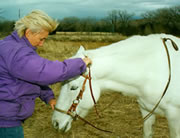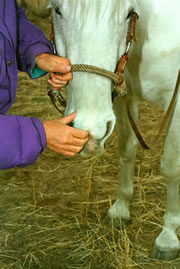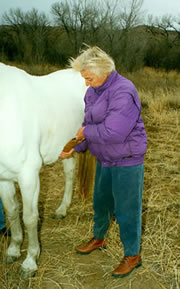TTEAM® Colic Techniques
by CA Lang, TTEAM Instructor
If you think your horse is sick, first take the temperature, pulse and respiration, listen for gut sounds, and check his gums for color and capillary refill time. If you do these things before calling the veterinarian, it will help the vet determine the urgency of his or her arrival.
Knowing your horse's normal resting pulse and respiration ahead of time will give you a more accurate evaluation of the situation.
Normal Ranges
- Temperature: 99.0 - 101° Fahrenheit or 37.5 - 38° Celsius
- Pulse: 30 - 40 beats per minute
- Respiration: 8 - 12 breaths per minute
- Gum Color: pinkish
- Capillary refill: 1 - 1 1/2 seconds
- Gut sounds: listen just behind the ribs for sound as well as frequency of sound
If you have your horse boarded or in the care of others, post a chart with your horse's normal ranges where they can be easily seen and used if you are unavailable.
 After calling the veterinarian, start working on your horse's ears. Start at the base of the ear, fold the ear on itself with your fingers on one side and thumb on the other, and slide along the length of the ear. When you reach the tip, rub it between your thumb and fingers to activate the shock point. Keep repeating the slide and the rub of the tip. You can also make circles or rub around the base of the ear, where it joins the head, to activate the acupuncture point for digestion and respiration.
After calling the veterinarian, start working on your horse's ears. Start at the base of the ear, fold the ear on itself with your fingers on one side and thumb on the other, and slide along the length of the ear. When you reach the tip, rub it between your thumb and fingers to activate the shock point. Keep repeating the slide and the rub of the tip. You can also make circles or rub around the base of the ear, where it joins the head, to activate the acupuncture point for digestion and respiration.
Working the ears in the case of colic, or any other situation where shock is a factor, helps to balance an animal's system and bring, or keep, him out of shock. Working each ear individually, rather than both at the same time, usually is more effective. Also, you can stroke an ear while walking the horse if the horse seems to prefer moving. If the horse is standing or lying and not trying to roll or to thrash, do the TTouch techniques without walking. Consider that the horse might be tired or exhausted from hours of discomfort and might need to rest. The TTouch can relieve many of the horse's symptoms without added stress.
 Working the ears is most important since it affects the entire system of the horse, but there are other helpful techniques. Rub or circle the muzzle between the nostrils, or directly on the gums, as this is an acupressure point for pain. Since the area over the croup often swells in cases of severe colic, gently work this area with the circular TTouch.
Working the ears is most important since it affects the entire system of the horse, but there are other helpful techniques. Rub or circle the muzzle between the nostrils, or directly on the gums, as this is an acupressure point for pain. Since the area over the croup often swells in cases of severe colic, gently work this area with the circular TTouch.
 Abalone circles on the flank and loin and abdomen are comforting. Gently pull the top hairs of the tail or rub the very end of the dock. Rub or make circles on the skin above the anus, a point that releases gas.
Abalone circles on the flank and loin and abdomen are comforting. Gently pull the top hairs of the tail or rub the very end of the dock. Rub or make circles on the skin above the anus, a point that releases gas.
The belly lift is very helpful for "gassy" horses. Use a towel (folded six to twelve inches wide) or girth, or hold hands with your partner, under the belly of the horse. Start near the elbows and work back as far as you can. Lift slowly, hold 6 - I 0 seconds (longer with some colic depending on the horse's response), and release more slowly than the lift. After each release, move the towel, girth or hands back about six inches. Remember that the flank is often tight or distended in colic so the pressure of the lifts should be adjusted accordingly.
 Each lift can be guided by one of the lifters. For example: "Lift, 2, 3, 4; Hold, 2, 3, 4, 5, 6; Release, 10, 9, 8 . . . 3, 2, 1." Notice that the release takes longer in order to insure a soft, gradual lessening of the pressure. Using hot towels has proved effective for some horses (or in cold weather - a Thermo-pad folded into a towel could be used). In many cases gut sounds become more active and the horse is able to pass gas after a few sets of lifts from elbow to flank.
Each lift can be guided by one of the lifters. For example: "Lift, 2, 3, 4; Hold, 2, 3, 4, 5, 6; Release, 10, 9, 8 . . . 3, 2, 1." Notice that the release takes longer in order to insure a soft, gradual lessening of the pressure. Using hot towels has proved effective for some horses (or in cold weather - a Thermo-pad folded into a towel could be used). In many cases gut sounds become more active and the horse is able to pass gas after a few sets of lifts from elbow to flank.
Work within the comfort zone of the horse. You won't know what type of colic the horse is suffering until your veterinarian makes his diagnosis, but the lifts cannot harm the horse even if it is more than gassy colic and can provide relief from pain as well as release gas.
You can do belly lifts by yourself. Place your hands and forearms under the horse's belly and lift, hold and slowly release. If a horse is lying down and someone is at his head and the horse is very quiet but in a lot of discomfort you could stand behind his back and reach over and place your hands and arms along the abdomen and lift toward his spine. Caution: in this case, as with all ways of helping a distressed animal, be aware of your safety. Be safe, not sorry. Make sure that you can stay in balance while doing something and that you can move out of the way of danger quickly and quietly.
A second way of doing belly lifts alone, is to use a long towel or piece of cloth or a sweatshirt or jacket. If you are standing on the left side of the horse, with your right hand, hold one end of the towel on the left side about four inches below the top of the spine. The towel drapes over the spine and down the right side. With your left hand, reach under the horse's belly and bring the towel to the left side. While holding the towel in this way, keep your back straight and knees bent and then lift. Your knees become straighter and the lift comes from your body and not only from your hands or arms.
Depending on your height and the height of the horse, you might be able to have your right hand on the right side oft he horse's body, especially with a pony. However, having the towel over the spine does not cause pressure on the spine. Reassure yourself of this fact by practicing on a horse sometime and have someone place a hand between the towel and the spine. It is very easy to slip a hand under the towel. Holding the towel in this fashion insures that the lifter can stand in a balanced way and can lift her body and is able to be completely aware of the body language of the horse.
This way of doing belly lifts also makes them very easy to do as maintenance for pregnant mares, in particular maiden mares, of for horses who seem prone to digestive upsets, or who are cinchy.
In the flank area, use the Abalone Touch (flat hand) to move the skin in gentle, large circles. Or with the flat hand, starting with the hand at 6 o'clock, move the skin in a quarter circle to 9 o'clock, pause and then return the skin back to 6 o'clock and then release. You can also use the Abalone on the underside of the horse's belly.
Since several ways of using TTEAM have been explained, you might wonder what to do first, second etc. Since ear work is useful for injury, illness, stress or nervousness, start with the cars. Doing belly lifts on a horse that needs to move or is kicking is out of the question. In each case you'll find the right combination for that particular horse with his unique symptoms. You have several tools; better yet, you have a way that you can help your horse in an emergency while you are waiting for the veterinarian.
TTEAM has many case histories of colicky horses helped with the TTouch. If you have used these techniques, please write. You might discover additional ways of applying these techniques.
| Important Point: |
TTEAM is never intended to replace the care of a veterinarian. It does, however, give you positive, helpful suggestions you can do while waiting for the vet or in situations where it is not possible to get one, such as while packing in the mountains or out on a distant trail. |
For Other Animals, too!
Many of these suggestions for colic can be applied to other animals including humans. Dogs, cats, cows, llamas, goats can also suffer from gastrointestinal disorders. Using the belly lifts, ear work and TTouch can benefit these animals as well.
